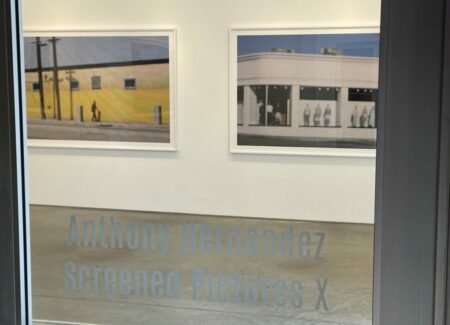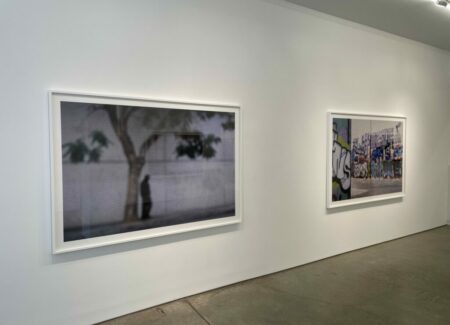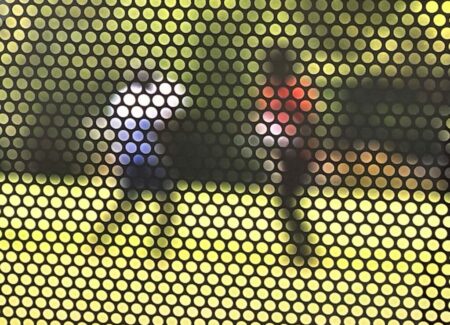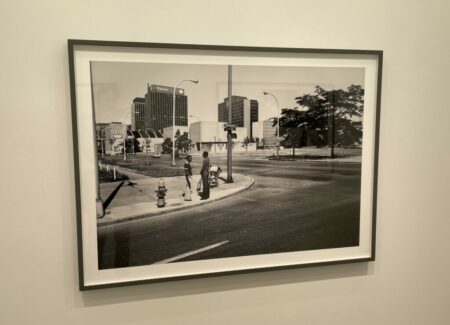JTF (just the facts): A total of 12 color and black-and-white photographs, framed in white/black and unmatted, and hung against white walls in the main gallery space and the smaller side room. 7 of the works are archival pigment prints (in color), made between 2018 and 2021. These prints are sized 57×82 inches each, and are available in editions of 5. The other 5 works are archival pigment prints (in black-and white), made in 1983 and printed in 2022. These prints are sized roughly 40×54 inches each, and are available in editions of 5. (Installation and detail shots below.)
Comments/Context: As photographic subjects go, the humble bus stop turns out to offer much more potential complexity than we might first imagine. Across the years, photographers have closely observed the local architectural variety to be found in such stops around the world, from bare bones benches (or nothing at all but a simple sign where people gather) to more elaborate concrete structures and shelters from the elements. And these artists have similarly watched closely as people come and go (and more often, simply spend time waiting), as public bus systems are a great social and cultural equalizer, with folks from all walks of life thrown together in close proximity, both in rural and urban situations.
In a sprawling metropolis like Los Angeles, the bus system provides a vital transportation lifeline for those without access to their own car, but with the geography itself seemingly encouraging a car-centered lifestyle and chronic under investment in alternate transport options, the bus can also feel like an overlooked afterthought. For Anthony Hernandez, a Los Angeles native, his interest in how life was unfolding at bus stops began some forty years ago, in the late 1970s, with a large format photography project called Public Transit Areas (briefly reviewed here). In it, he made images of LA bus stops and their surroundings, deliberately working on foot and documenting those waiting in the unshaded Southern California sun. His photographic results were filled with compassionate nuance and formal clarity, capturing an insightful sample of practical behaviors taking place at these often invisible locations.
As seen in his 2016 SFMOMA retrospective (catalog reviewed here), Hernandez has spent most of his artistic career thinking about the many contours and complexities of life in Los Angeles. And while his artistic reputation has deservedly become more prominent in recent years, his most recent works find him returning back to the forgettable bus stops of Los Angeles once again, with a renewed sense of attentiveness and invention. In the intervening years since he had last made them his subject, many of the bus shelters have become more substantial, with paneling surrounding the benches, both as protection from sun, wind, and rain, and a convenient spot for advertising. Many of those panels have been made from a metal mesh that provides a transparent screening effect, and it is this unassuming architectural feature that has offered the framework for Hernandez’ new series of photographs.
Instead of looking inward at the bus stops and the waiting passengers (as he had done before), in these recent works, Hernandez has stood inside (or near) the shelters, and looked outward through the screened walls at the surrounding city. The perforated motif breaks up the images into neat arrays of colored circles, with black veiling in between; the visual effect is something between deliberate squinting blur or anonymizing pixelization and an up-close inspection of the halftone dots used for imagery in newsprint and magazines. In this way, the bus stop literally becomes the optical interrupter, and we see life in Los Angeles through its unlikely lens.
Hernandez’ compositions are generally pared down to simple understated essentials, taking in the sun-blasted storefronts nearby or catching a lone pedestrian walking near a flat expanse of wall across the street, like a ghostly silhouette. He plays with the impressionistic possibilities of spackled color more overtly in an image of graffiti, and another of a park scene where two figures talk, play, or perhaps fight on the green grass. And he turns a bit more moody and ominous in images of a huddled lump on the street of what was probably a homeless person (the screening makes specific identification somewhat impractical) and a single man walking through an empty zone of light poles and rubble, traversing the apocalyptic space with bleak determination; in both of these scenes, Hernandez’ palette seems to have been drained, leaving behind a nearly monochrome representation, and the compositions have been divided by available verticals, making the space all the more fractured.
While a sunny yellow wall with blue windows decorates the background of one sidewalk image, even this brightness can’t overcome a deeper feeling of loneliness that simmers through these screened pictures. Other details seem to signal a similar sense of gloomy isolation, from a leafy tree that overhangs the sidewalk, reaching down with implied menace over a shuffling dark figure, to the blank mannequins fighting the punishing sun, with no actual shoppers anywhere in sight. Seen as a body of work, these images feel hazily separated, the visual interruption of the bus shelter capturing the impersonal distance felt by Los Angeles’s bus-riding residents. As an aesthetic device, the screen is clever and effective, but its ultimate impact feels quietly disheartening, making the separations of the modern city all the more visible.
How people occupy urban emptiness is also a theme to be found in Hernandez’ earlier black-and-white images from 1980s Syracuse, which are on display in the side room. Here office workers on their lunch breaks sit in plazas with fountains, blocky concrete steps, and spaced benches, often lost in thought as they sit alone, getting some sun or fresh air. One woman finds repose by dipping her feet in the water, another clutches a Pepsi Free with primly slumped resignation, and a third man leans back trying to find a comfortable position on the sunny but unforgiving steps. Hernandez also documents the alone together phenomenon of the city, where individuals sit at the far ends of benches, sharing the same space but still entirely disconnected; one pair of men seems particularly awkward, one looking wide-eyed while the other looks away clutching his sack lunch. These earlier images show that Hernandez has been excavating the nuances of this kind of overlooked urban behavior for decades now, teasing out the ways we struggle to inhabit such places.
With a limited number of these large screened pictures on display in this show, it is dangerous to extrapolate patterns across what is undoubtedly a much larger body of imagery. Hopefully a more expansive photobook is in the works that will dive deeper into the different ways Hernandez has leveraged this novel interruption motif, including the softening painterly effect on color and the anonymizing and abstracting aspects of blurring; Hernandez’ work has consistently been informed by precise formal control, and seeing a wider sample of this series might make clearer how he has adapted his image construction and framing to the constraints of the bus shelter screens.
What is clear is that this new aesthetic device has offered Hernandez a way to capture a sense of implicit tension that is otherwise hard to visualize. His photographs push the streetscape to the edge of breakdown, where the reduction in detail actually enhances the uncertain emotional power of what is left behind. By smartly stripping these scenes back to hints and essences, Hernandez has opened them up to broader interpretation.
Collector’s POV: The works in this show are priced as follows. The larger color prints are $28000, while the black and white prints are $14000 each. Hernandez’ work has little recent secondary market history, so gallery retail likely remains the best option for those collectors interested in following up.

















I admire the way he identified a fresh new way of making images on his life-long theme. Some of these images are strikingly elegant and lush.
Some video of him on Frieze talking about his work – https://www.frieze.com/video/la-my-studio-anthony-hernandez-showing-work-his-hometown